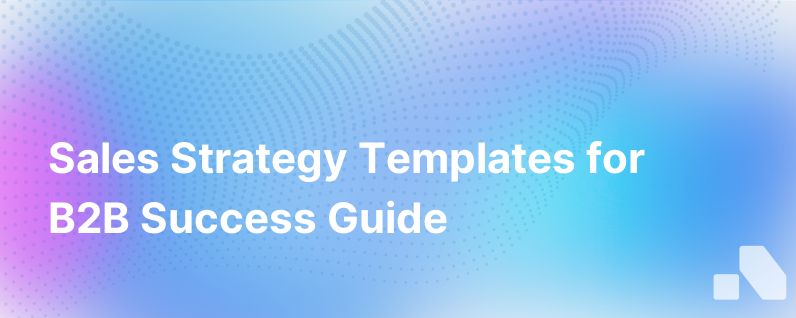
In the intricate world of B2B sales, having a robust strategy is not just an asset – it's a necessity. Sales strategies in the B2B realm require a level of sophistication and detail that goes beyond common templates and pre-set paths. Crafting a sales strategy that is both unique to your company's strengths and adaptable to the fluid market landscape can determine the height of your success.
This guide isn’t just a walkthrough; it's an arsenal of strategic tools aimed at propelling B2B entities to the pinnacle of their sales potential.
Identifying and Understanding Your Ideal Customer
Sales strategies begin with the customer. Who are they? What drives their decision-making? What challenges do they face? Your ideal customer profile should evolve beyond demographics and firmographics into psychographics and behavioral data – a hologram of real prospects, with needs and objectives etched into their definition.
Demographics: Look at company size, location, industry sectors.
Psychographics: Understand their values, attitudes, and aspirations.
Behavioral Data: Analyze how they use products, their buying patterns, and service feedback.
Strategic Goal Setting and Sales Planning
A roadmap without a destination and milestones is no roadmap at all. Goals should be S.M.A.R.T - Specific, Measurable, Achievable, Relevant, and Time-bound. Each goal needs to align with broader business objectives: market capture, revenue growth, market penetration, etc. This alignment ensures that your sales team's successes translate into growth for the company.
A strong goal might be to increase the customer base in a specific sector by 20% within the next fiscal year, or to grow the average customer value by 15% through upselling additional services.
Crafting a Competitive Pricing Strategy
Your pricing strategy is a pivotal force in your market success. It should be as dynamic as your market itself, accommodating different customer needs, market demography, and competitive landscapes. Are you aiming for market penetration with lower pricing? Or do you wish to position yourself as a premium provider?
Remember, pricing is not just about numbers; it's about perceived value – crafting a narrative around your pricing that resonates with your clients' understanding of quality and worth.
Drafting a Nimble Marketing Plan
In tandem with direct sales efforts, your marketing must be attuned to the B2B parlance. It should articulate the uniqueness of your offerings and synchronize with your sales strategies. Whether through content marketing, social media presence, or direct outreach, every touchpoint should move the prospect through the sales funnel.
Strategic marketing can also focus on demand generation, a precursor to lead generation, where your task is to craft communication that captures and leads the market demand towards your offerings.
Leveraging Cutting-Edge Sales Technology
Your sales technology stack is an extension of your strategy. Customer Relationship Management (CRM) systems, sales acceleration tools, communication platforms, and analytics should not just support your strategy; they should refine and redefine it.
Effective use of such tools can automate mundane tasks, refine lead qualification, nurture client relationships, and provide deep insights into your sales funnel's health.
Fostering Collaboration and Communication
Internal communication is just as crucial as your external messaging. Sales strategies ought to be living documents – crafted with the input of every stakeholder, from sales executives to product developers. Regular strategy meetings, clear lines of communication, and an open-door policy for insights and observations are integral.
Iteration and Adaptability: The Heart of B2B Strategy
The sales landscape is ever-evolving. Feedback loops, market analysis, customer responses, and performance metrics should continuously inform your strategy. It's not a set-and-forget affair; it's a dynamic blueprint that breathes and grows with the market and your own business.
Iterate based on performance data, both the successes and the setbacks, for your sales approach should be a learning organism, capable of evolving with every sale.
Conclusion:
In the high-stakes world of B2B sales, a piecemeal approach will leave you in the wake of more strategic competitors. This guide lays out the fundamental structure of a comprehensive B2B sales strategy, yet your company's unique value proposition and market intelligence will ultimately define its contours.
Whether you're a fledgling startup or an established enterprise, aligning these strategic templates with actionable insights and technology can exponentially elevate your sales effectiveness. Aomni’s AI platform precisely caters to this alignment – facilitating real-time account research, competitive insights, and personalized sales content, enhancing the strategic thrust behind every sales push.
Remember, the anatomy of a successful B2B sales strategy is never complete without constant learning, testing, and refining. Consider this guide as the groundwork upon which your sales success will be built.
For more insights into building a seamless B2B sales strategy like the ones Aomni delivers, stay tuned to our comprehensive resources and intelligence solutions designed for B2B sales excellence.
Sources:
- B2B Sales Strategy Template by ClickUp™
- 10 Essential Steps to a Successful B2B Sales Strategy - Trendemon
- Ultimate Guide to B2B Sales Forecasting Accuracy
- How to Create a Sales Strategy for B2B Sales
- Complete Guide to B2B Sales Demand Forecasting in 2024
- Expert Tips for Effective B2B Sales Forecasting | Discern
- How to Create a B2B Sales Plan (Steps, Tips & More) | Anaplan
- How to Create a B2B Sales Plan: Template + Examples